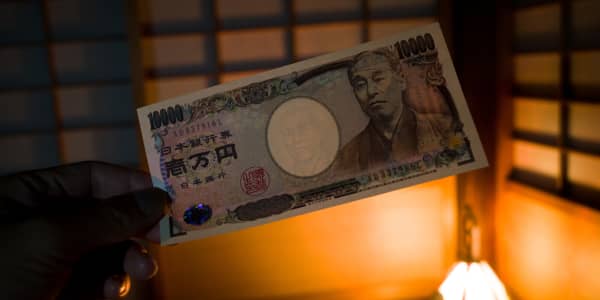After a week of collapsing asset prices, moves from central banks to weaken their country's currencies have proved frustratingly short-lived, leaving analysts scratching their heads as to what policymakers can do next to intervene.
Normally when a country loosens monetary policy and cuts their interest rates, investors pull their money out in search of higher yields elsewhere. This pushes down the value of the currency -- hopefully stimulating growth by helping exporters gain market share and making debt repayments cheaper.
But as central bank's appear to be running out of options, their moves to weaken have become increasingly unsuccessful.
Days after the Bank of Japan introduced negative interest rates on excess reserves in an attempt to weaken its currency, the was on track for the strongest week since late 2008 against the dollar on Friday, as investors flocked to the traditional safe-haven asset amid market turmoil.
On Thursday, Sweden's Riksbank moved its interest rates further into negative territory with a deeper-than-expected cut, resulting in nothing more than a "fleeting impact" on its currency, the Swedish crown, which has recouped all of its losses already and even strengthened against the euro.
Before this, the European Central Bank's well-telegraphed rate cut in December was part of an "underwhelming package" that also saw the euro rally, according to global head of foreign exchange strategy at HSBC, David Bloom.
So where next and how do traders navigate this unpredictable terrain, where even extreme moves from central banks into negative territory are seemingly having little to no intended impact on foreign exchange markets?
Analysts suggest the Bank of Japan may move to intervene directly, but given a 2013 G20 communique that advises all members against any policy that could be interpreted as competitive devaluation.
"I think any intervention won't go down very well. From that point of view I think what we will see is some attempts to talk down the currency," Valentin Marinov ,head of G10 FX research at Credit Agricole, told CNBC.
"But talk is cheap. For the Japanese officials will be looking at another part of that G20 communique where official intervention may be warranted to avoid disruptive moves in the markets. But for the time being it feels like intervention still not on the cards," he added.
Bloom suggests that the threat of a policy initiative to weaken the Japanese currency now moves back to direct yen sales. However, this is a contentious issue, given that the yen is still considered relatively weak on a number of different metrics.
"Direct foreign exchange intervention is the most likely choice and the currency market will need to be mindful of this event risk. There may be questions about the justification for direct intervention given the yen is undervalued, or on intervention's likely chances of success, but such considerations are unlikely to deter action if the yen continues to strengthen rapidly," Bloom said.
Citi said the main principle in a "policy-ineffective" world is to buy currencies that are safe havens and whose central bankers are likely to be deterred from easing due to a lack of policy effectiveness.
At the same time, sell currencies whose central banks see room to ease further even if the odds favor policy ineffectiveness.
"When policymaker hands are restrained, the normal policy reaction function that links easing to poor outcomes is derailed. This makes risk-off outcomes more likely," said Global Head of G10 FX Strategy at the bank, Steven Englander.
"We put yen, euro, Swiss franc, sterling, and U.S. dollar into the traditional safe haven category. In the current context we exclude the dollar as long as investors keep seeing a flattening of the expected rate hike path. The dollar is vulnerable until this process is completed," he said.
Meanwhile, analysts at Societe Generale said the growing realization about central banks' waning powers has prompted a rush into safe-haven currencies, with strong currencies year to date being those countries with big current account surpluses.
"The next (now the current) stage is a re-think about Fed tightening (by the market to a greater extent than by Janet Yellen and the Federal Open Market Committee). There's not so much to support the dollar in this phase, and so it is weakening against a range of current account surplus economies," said global macro strategist at the bank, Kit Juckes.
"From here, a pause in proceedings isn't impossible, but within G10 FX we would fade any bounce in sterling, , New Zealand dollar and even the Canadian dollar against euro, Swiss Franc, yen, Norwegian crown and even Swedish crown," he added.








